It’s been a couple weeks since the Local Orbit team returned from the National Food Hub Conference, and there’s a lot to share about the event. The conference provided a great opportunity to connect with customers and hear from business leaders about the challenges and opportunities in the industry.
One of the consistent themes we heard concerned creating a connected local food system. From the USDA and Surdna Foundation’s announcement of funding for value-chain coordinators to casual conversations about the challenges of connecting to regional partners, there was a lot of talk about networks. While the challenges of a networked food system are significant, the opportunities represent an opportunity for growth. One of Local Orbit’s core goals is the creation of a networked food system.
We have had many conversations with our customers about creating trading networks. Recently, we spoke to Headwater Food Hub in New York about connecting to customers further south that could supply leafy greens during the winter. We’re excited about these relationships, as they represent the next phase in the emerging local food economy. It has the potential to drive collaboration and extend value throughout the supply chain. But a network has many permutations, from casual communities of practice to regional business partnerships.
How can we leverage both to grow the local food supply chain?
Events like the National Food Hub Conference – a production of the National Good Food Network – are a great example of the important work a network can do to connect industry leaders and stakeholders. The event brings together hundreds of people. Emerging industries need networks like this to grow, and there are food hub and local food networks across the US that do this on a regional scale.
These communities can provide significant benefit to emerging supply chains, connecting like-minded stakeholders while providing learning opportunities. They’re an important part of rebuilding the local food system. But building these types of networks aren’t the end goal – they provide context and help identify points of collaboration. Ultimately, this should lead to tangible business partnerships for the individuals and businesses that work in local food supply chains.
And these networked business opportunities are emerging as the local food economy scales. Creating trading and logistics connections will become increasingly necessary so hubs can access diversified supply and meet the growing demand from buyers. Providing tools and processes so businesses can easily trade together is an essential first step. Solving the challenging issue of logistics and transportation is probably the biggest hurdle, but some regional networks have already started to tackle this. We can learn a lot from them. It’s exciting for us to see the beginnings of these business partnerships, many which are supported by our services.
How can we expand this to better address market needs? Local Orbit’s vision for a connected local food system leverages region-wide partnerships to increase purchasing of local food, while using data to inform future plans.
In our next post about the networked food system, you’ll learn how a food bank network and the Colorado Food Hub Network work with regional partners to diversify their products while providing tools and resources that strengthen the supply chain.

